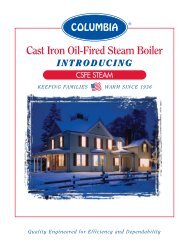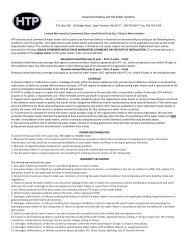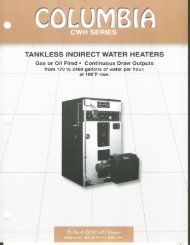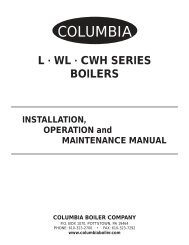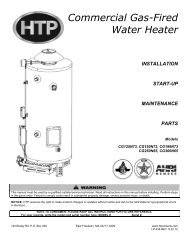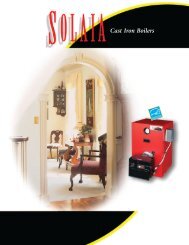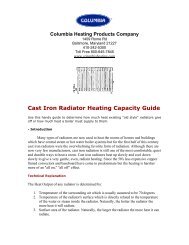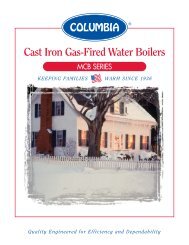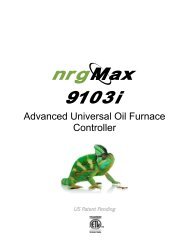LVWO Waste Oil Boiler - Columbia Heating
LVWO Waste Oil Boiler - Columbia Heating
LVWO Waste Oil Boiler - Columbia Heating
Create successful ePaper yourself
Turn your PDF publications into a flip-book with our unique Google optimized e-Paper software.
2. Remove the refractory by cutting and scrapping the refractory out of the cover. Therefractory is glued into the cover in four spots. Scrap remaining glue and refractory offof the inside of the cover.3. Place a small amount of high temperature adhesive on the inside of the cover in four spotsto hold the refractory. Press the replacement refractory into the cover.4. Replace the rear cover, flat washers and nuts. Tighten nuts evenly until refractory forms atight seal around boiler frame.DrainingA clean, properly maintained heating boiler should not be drained unless there is a possibility offreezing, unless the boiler has accumulated a considerable amount of sludge or dirt on the waterside, or unless draining is necessary to make repairs. Very little sludge should accumulate in aboiler where little to no makeup water is added to a properly operating system.Antifreeze• Antifreeze solutions when used in heating systems should be of the ethylene glycol basetype with an inhibitor added.• Antifreeze concentrations should be not less than 33% no more than 66%. The servicelife of antifreeze depends on such factors as heating system design, hours of operation,aeration and rates of contamination. Therefore, the antifreeze solution should be tested atleast once per year and as recommended by the manufacturer.• Antifreeze solutions are harmful or may be fatal if swallowed, therefore antifreezesolutions should only be used in closed circulating systems.• Antifreeze solutions expand more than water for a given temperature rise. Allowancemust be made for this additional expansion when antifreeze solution is used in the heatingsystem.Fireside Corrosion• Some fuels contain substances which can cause fireside corrosion. Sulfur, vanadium andsodium are among the materials which may contribute to this problem.• Preventing this trouble from this source depends greatly on keeping the boiler heatingsurfaces dry. It is recommended to eliminate this problem that the boiler watertemperature be maintained at 120 degrees F year round and that the input is adjusted thata minimum stack temperature of 400 degrees F is maintained.Sealants• Sealants may have a detrimental effect on boilers, pumps, relief valves, etc. and are notrecommended to be used in hot water heating boilers.<strong>LVWO</strong> Manual Page 30 of 48



